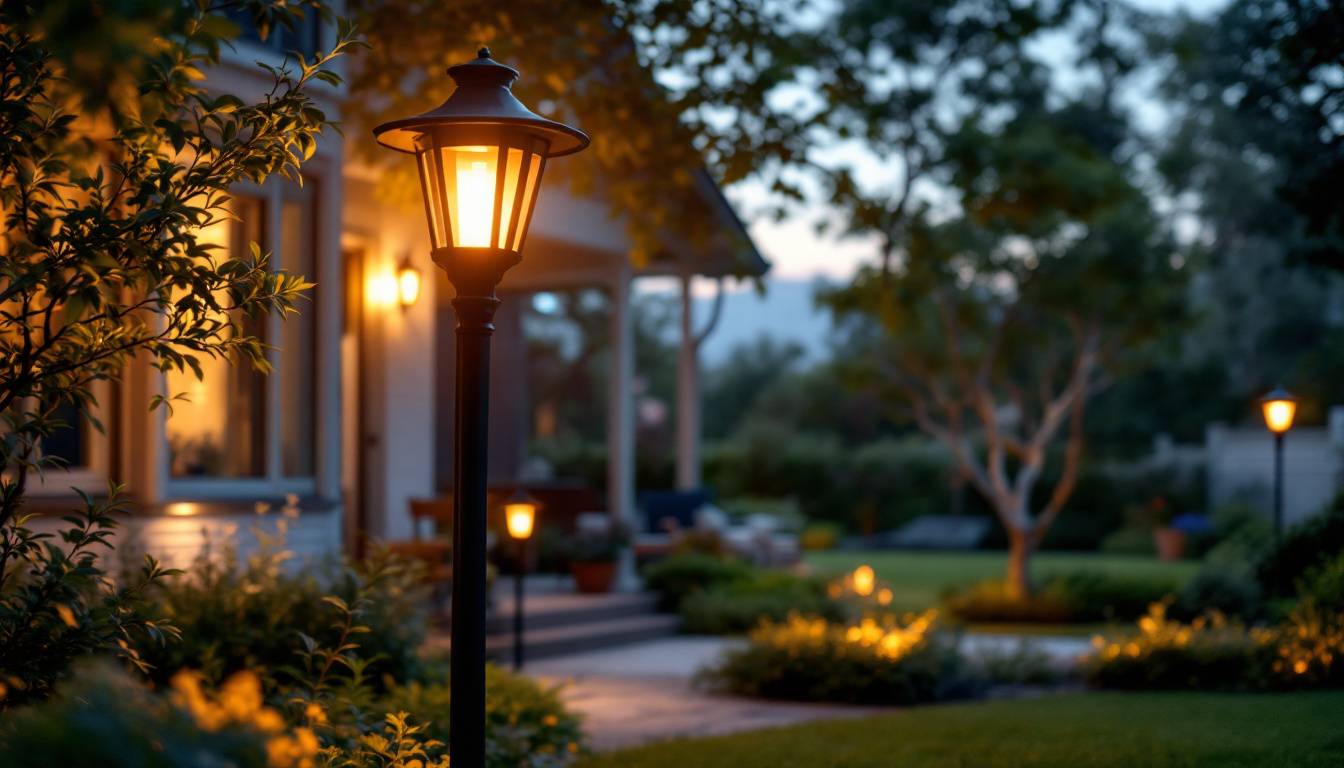
As the demand for energy-efficient and sustainable lighting solutions continues to grow, solar motion outdoor lights have emerged as a popular choice among homeowners and businesses alike. For lighting contractors, understanding the best practices for installing and maintaining these systems is essential to ensure customer satisfaction and optimal performance. This article delves into the best practices for solar motion outdoor lights, tailored specifically for lighting contractors.
Solar motion outdoor lights are designed to illuminate outdoor spaces while conserving energy. They harness solar energy through photovoltaic panels, which convert sunlight into electricity. This electricity powers LED lights, providing illumination only when motion is detected. This dual functionality not only enhances security but also minimizes energy consumption. As a result, solar motion lights are an eco-friendly alternative to traditional lighting systems, making them an attractive option for environmentally conscious homeowners.
To effectively work with solar motion lights, it is crucial to understand their key components. These typically include solar panels, batteries, motion sensors, and LED lights. Each component plays a vital role in the overall performance and efficiency of the lighting system. The solar panel captures sunlight during the day, charging the battery that stores energy for nighttime use. The motion sensor detects movement, triggering the LED lights to turn on. Understanding how these components interact will help contractors provide better installation and maintenance services.
In addition to these core components, many modern solar motion lights come equipped with advanced features such as adjustable sensitivity settings and timers. These enhancements allow users to customize their lighting experience based on their specific needs and preferences. For instance, a homeowner may want the lights to remain on for a longer duration when motion is detected during social gatherings in the backyard, while opting for shorter activation times during quiet nights. This level of customization not only improves user satisfaction but also optimizes energy efficiency, ensuring that the lights are only active when truly necessary.
There are various types of solar motion lights available on the market, each designed for specific applications. Some common types include wall-mounted lights, flood lights, and garden lights. Wall-mounted lights are ideal for illuminating entryways and pathways, while flood lights provide broader coverage for larger areas. Additionally, decorative solar lights can enhance the aesthetic appeal of gardens and patios, creating a warm and inviting atmosphere.
Contractors should assess the specific needs of their clients to recommend the most suitable type of solar motion light. Factors such as the area’s size, the desired brightness level, and the aesthetic preferences of the homeowner can influence the choice of lighting. Furthermore, considerations such as the local climate and typical weather conditions should not be overlooked, as these can impact the performance and longevity of solar lights. For example, regions with prolonged cloudy weather may require lights with larger solar panels or higher-capacity batteries to ensure consistent performance. By taking these factors into account, contractors can provide tailored solutions that meet both functional and aesthetic requirements, ultimately leading to greater customer satisfaction.
Proper installation is crucial for the effective performance of solar motion outdoor lights. Following best practices not only ensures optimal functionality but also enhances the longevity of the lighting system.
Before installation, a thorough site assessment is essential. This involves evaluating the area where the lights will be installed, considering factors such as sunlight exposure, potential obstructions, and the intended purpose of the lighting. Areas with limited sunlight exposure may require additional considerations, such as the use of higher-capacity batteries or alternative lighting solutions.
Contractors should also take into account the local climate and weather conditions. For instance, regions with heavy snowfall may necessitate the installation of lights at higher elevations to prevent snow accumulation from obstructing the solar panels.
Placement is a critical factor in maximizing the efficiency of solar motion lights. Ideally, solar panels should be positioned to receive direct sunlight for the majority of the day. This often means installing them on rooftops or high on walls, away from trees or other structures that may cast shadows.
In addition to sunlight exposure, the placement of motion sensors is equally important. Contractors should ensure that the sensors are positioned to cover the intended area effectively, with minimal obstructions that could hinder their performance. Testing the sensor’s range before finalizing the installation can help ensure optimal functionality.
While many solar motion lights are designed to be wireless, understanding the wiring and connections involved in hybrid systems can be beneficial. For systems that include hardwired components, it is essential to follow manufacturer guidelines to ensure safety and compliance with local electrical codes.
Contractors should also be aware of the importance of weatherproofing connections, especially in outdoor installations. Using weather-resistant materials and ensuring that all connections are secure can help prevent issues caused by moisture or extreme weather conditions.
Regular maintenance is vital for the longevity and performance of solar motion outdoor lights. Lighting contractors should educate their clients on best practices for maintaining these systems to ensure they continue to function optimally over time.
One of the most critical maintenance tasks involves keeping the solar panels clean. Dust, dirt, and debris can accumulate on the panels, reducing their efficiency and overall performance. Contractors should recommend that homeowners periodically clean the panels with a soft cloth or sponge and mild soap to remove any buildup.
In areas with heavy pollen or pollution, more frequent cleaning may be necessary. Providing clients with a maintenance schedule can help ensure that the solar panels remain in optimal condition, maximizing energy absorption and light output.
The battery is another crucial component that requires attention. Over time, batteries may lose their ability to hold a charge, necessitating replacement. Contractors should inform clients about the signs of battery degradation, such as dimming lights or shorter operational periods.
It is also essential to educate clients on the importance of using compatible batteries for replacements. Using the wrong type of battery can lead to performance issues and may void warranties.
Encouraging clients to conduct regular inspections of their solar motion lights can help identify potential issues before they become significant problems. This includes checking for physical damage, ensuring that motion sensors are functioning correctly, and verifying that lights are illuminating as expected.
Contractors can offer annual or semi-annual inspection services to help clients maintain their systems effectively. This proactive approach not only enhances customer satisfaction but also positions contractors as trusted experts in their field.
While solar motion outdoor lights offer numerous benefits, they can also present challenges that contractors should be prepared to address. Understanding these common issues and their solutions can enhance the overall customer experience.
One of the most common challenges faced by solar motion lights is limited sunlight exposure. Factors such as tall buildings, trees, or other obstructions can significantly reduce the amount of sunlight the solar panels receive. In such cases, contractors may need to explore alternative solutions, such as recommending lights with larger solar panels or higher-capacity batteries.
Additionally, installing lights in areas that receive direct sunlight for more extended periods can help mitigate this issue. Conducting a thorough site assessment can aid in identifying the best locations for installation.
Another challenge is the sensitivity of motion sensors. Some clients may find that their lights are too sensitive, triggering with minimal movement, while others may experience the opposite issue. Educating clients on how to adjust sensor settings can help address these concerns.
Contractors should be familiar with the specific sensor settings of the products they install. Providing clear instructions on how to adjust sensitivity levels can empower clients to customize their lighting experience according to their preferences.
Weather conditions can also impact the performance of solar motion lights. Extreme temperatures, heavy rain, or snow can affect battery performance and overall functionality. Contractors should advise clients on the importance of choosing weather-resistant models and ensuring proper installation to withstand local weather conditions.
In areas prone to severe weather, recommending lights with robust construction and higher IP ratings can provide added peace of mind for clients. Understanding the specific environmental challenges of a region can help contractors make informed recommendations.
The solar lighting industry is continuously evolving, with new technologies and trends emerging regularly. Staying informed about these developments can help contractors remain competitive and offer the best solutions to their clients.
One of the most significant trends in solar motion lighting is the integration of smart technology. Many modern solar motion lights now come equipped with features such as smartphone connectivity, allowing users to control their lights remotely. This technology provides added convenience and enhances the overall user experience.
Contractors should familiarize themselves with these smart features and be prepared to assist clients in setting up and managing their systems. Offering installation services for smart solar lights can position contractors as forward-thinking professionals in the industry.
As technology advances, solar motion lights are becoming increasingly energy-efficient. New LED technologies and improved solar panel designs are enhancing the performance of these systems, allowing for brighter illumination with less energy consumption.
Contractors should stay updated on the latest advancements in solar technology to provide clients with the most efficient and cost-effective solutions. Understanding energy efficiency ratings and certifications can also help contractors make informed recommendations.
Solar motion outdoor lights present a valuable opportunity for lighting contractors to offer sustainable and energy-efficient solutions to their clients. By understanding the components, installation best practices, maintenance considerations, and common challenges associated with these systems, contractors can enhance their expertise and provide exceptional service.
Staying informed about future trends and advancements in solar technology will further empower contractors to meet the evolving needs of their clients. With the right knowledge and approach, lighting contractors can successfully navigate the growing demand for solar motion outdoor lights, ensuring customer satisfaction and long-term success in the industry.
Ready to elevate your lighting projects with the best solar motion outdoor lights on the market? Look no further than LumenWholesale, where we offer contractors an unbeatable combination of quality, affordability, and convenience. Our spec-grade lighting products are designed to meet the highest industry standards, ensuring that your installations shine in performance and reliability. Take advantage of our wholesale prices, free shipping on bulk orders, and a selection that cuts out the middleman, giving you superior products at the best value. Don’t compromise on your lighting needs—choose LumenWholesale for hassle-free access to premium lighting. Wholesale Lighting at the Best Value is just a click away.

Explore the innovative strategies of Waffer Light, a leading smart lighting contractor, as they revolutionize the industry with cutting-edge technology and sustainable solutions.

Discover the common pitfalls lighting contractors face when converting fluorescent tube lights to LED.

Illuminate your outdoor space with expert advice from top lighting contractors.

Discover how optimizing your washing machine outlet can be the unexpected secret to securing more lighting contracts.